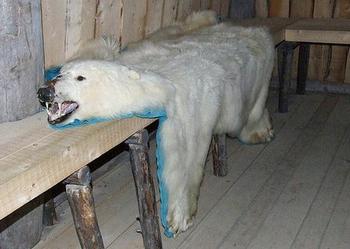
BANGKOK, Thailand, March 7, 2013 (ENS) – Governments have refused to ban trade in polar bear pelts, paws and teeth from Canada, amid what one observer called “controversial and frosty scenes” at the meeting of the Convention on International Trade in Endangered Species in Bangkok today.
A proposal from the United States to ban the trade in polar bears from Canada was rejected by delegates in an open vote to the despair of many animal welfare organizations who lobbied hard in favor of the proposed uplisting of polar bears for their protection.

Canada opposed the ban, claiming that the main impact on polar bears is climate change, leading to a reduction in Arctic sea ice.
The European Union was unable to broker a consensus and tabled a compromise to the delegation, which many saw as offering little additional protection for the threatened species.
The Canadian delegation also argued that the Inuit people, who lead hunts, were managing the number of bears appropriately, and that polar bear hunting is integral to their culture.
Under the proposed ban, Inuit people would have been able to continue hunting polar bears for sustenance, but skins and parts could not be exported.
The U.S. acknowledged that climate change and the increasing loss of the Arctic sea ice that polar bears need for survival pose the greatest threat to the 20,000 bears remaining in five range states, but argued that hunting pushes the imperiled bears closer to extinction.
Daniel Ashe, leader of the U.S. delegation and director of the U.S. Fish and Wildlife Service, told delegates from the 178 CITES nations, “Science paints a stark future for the polar bear. An [export ban] will give the polar bear a better chance to persist in the world until we can deal with climate change.”
Philip Mansbridge is CEO of Care for the Wild International, a British charity that has funded polar bear research in Canada for several years. “Polar bears deserve and need our protection, so it’s a sad day for one of the world’s most iconic creatures. It’s predicted that two thirds of the world’s polar bears will be gone by 2050 – so are we going to wait another 20 years before we try and do something about it?
During the meeting, Terry Audla, president of the national organization representing indigenous peoples of Arctic Canada, said that the uplisting of the polar bear would be an attack on Inuit people, and would not protect the polar bear, which would still be hunted at the same levels.
Mansbridge disagrees. “Prices for polar bear pelts have doubled over the last few years, and the signs are that trade is increasing. All the evidence says that it is simply unsustainable so it is foolish and negligible of us to allow it to continue when polar bear numbers are diminishing.”
“We need to stay ahead of the curve for once instead of waiting for the last polar bear to be standing before we do anything,” he said.
“It’s true to say that environmental factors are a key threat to the polar bears, but the trade in skins and body parts is significant,” said Mansbridge. “It’s terrible to think that we are postponing protecting such a magnificent animal so that hunters can continue to have their pay day.”
Care for the Wild cites reports showing that between 2001 and 2010 that 37,400 polar specimens were traded. This translates to the killing of 5,680 polar bears – an average of more than 500 or nearly two per day. The skins of 93 percent of these bears are exported.
The demand for polar bear pelts and their prices have increased over the last few years. One pelt was sold at auction in 2012 for US$12,500, twice the price of 2007.
Japan is main importer of these skins, along with China and some European countries.
Copyright Environment News Service (ENS) 2013. All rights reserved.
